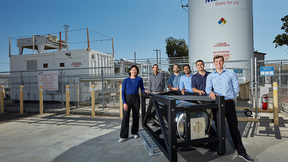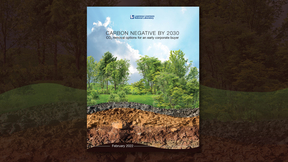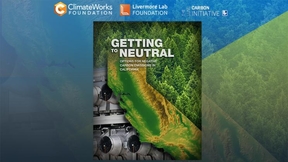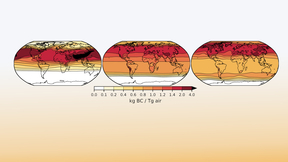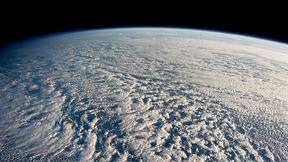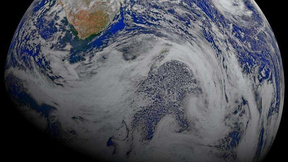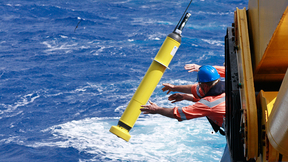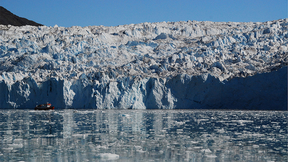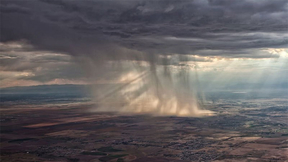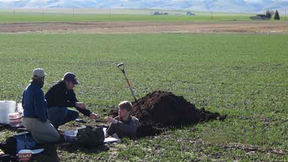Back
Particulate soil carbon may be more vulnerable to microbial decomposition under warmer temperatures associated with climate change. Soil organic matter contains more carbon than plants and the atmosphere combined. Soil is increasingly considered for its potential role in climate mitigation due to its ability to sequester more carbon, but it also is critical to understand…
Lawrence Livermore National Laboratory (LLNL) and Verne, a San Francisco-based startup, have demonstrated a cryo-compressed hydrogen storage system of suitable scale for heavy-duty vehicles. This is the first time cryo-compressed hydrogen storage has been demonstrated at a scale large enough to be useful for semi trucks, a milestone in high-density hydrogen storage…
Lawrence Livermore National Laboratory (LLNL) researchers, along with scientists from more than a dozen institutions, have completed a first-of-its-kind high-resolution assessment of carbon dioxide (CO2) removal (CDR) in the United States. The report, “Roads to Removal: Options for Carbon Dioxide Removal in the United States,” charts a path for the United States to achieve…
Lawrence Livermore National Laboratory (LLNL) scientists have provided input on Microsoft’s pathway to become carbon-negative by 2030. LLNL researchers built on their pivotal report "Getting to Neutral: Options for Negative Carbon Emissions in California," which has become a trusted adviser in the discussion of how to remove carbon dioxide from the air, to make…
Greenland wasn’t always covered in ice. In fact, within the last 1.1 million years, Greenland had thriving vegetation and ecosystems. That is the conclusion of an international group of researchers, including a scientist from Lawrence Livermore National Laboratory (LLNL), that analyzed sediment at the base of the Camp Century ice core (1.4 kilometers deep) collected in…
WHO George Peridas, director of carbon management partnerships, and staff scientist Briana Schmidt from Lawrence Livermore National Laboratory. Peridas is responsible for incubating partnerships that result in the advancement and deployment of carbon management solutions and technologies, including the removal of carbon dioxide from the atmosphere, or so-called negative…
To reach economy-wide carbon neutrality by 2045 or earlier, California will likely have to capture, transport and geologically store tens of millions of tons per year of carbon dioxide (CO2) from large sources and from the atmosphere. California has an extensive regulatory framework that is rigorous, robust and will safeguard the environment, public health and safety…
One year after publishing the groundbreaking "Getting to Neutral: Options for Negative Carbon Emissions in California," Lawrence Livermore National Laboratory (LLNL) has become a trusted adviser in the discussion of how to remove carbon dioxide from the air. In the report, LLNL scientists identified a robust suite of technologies to help California clear the last hurdle…
By looking at satellite measurements of temperature changes in the lower layer of Earth’s atmosphere, scientists found that climate models may have overestimated the decade-to-decade natural variability of temperature. Lawrence Livermore National Laboratory (LLNL) statistician Giuliana Pallotta and climate scientist Benjamin Santer created a statistical framework to…
A team of Lawrence Livermore National Laboratory (LLNL) researchers has found that the global climatic consequences of a regional nuclear weapons exchange could range from a minimal impact to more significant cooling lasting years. The five LLNL scientists examined the potential for global climate changes from large urban fires ignited in a hypothetical regional nuclear…
For the first time, scientists from Lawrence Livermore National Laboratory (LLNL) and five other organizations have shown that human influences significantly impact the size of the seasonal cycle of temperature in the lowest layer of the atmosphere. To demonstrate this, they applied a so-called "fingerprint" technique. Fingerprinting seeks to separate human and natural…
An international team of scientists, including one from Lawrence Livermore National Laboratory (LLNL), has found that up to 20 percent loss in the annual maximum amount of water contained in the Western United States’ mountain snowpack in the last three decades is due to human influence. Peak runoff in streams and rivers of the Western U.S. is strongly influenced by…
Lawrence Livermore National Laboratory researchers have identified a mechanism that causes low clouds -- and their influence on Earth’s energy balance -- to respond differently to global warming, depending on their spatial pattern and location. The results imply that studies relying solely on recent observed trends underestimated how much Earth will warm due to increased…
Scientists have found that changes in cloud patterns during the last three decades match those predicted by climate model simulations. These cloud changes are likely to have had a warming effect on the planet. Records of cloudiness from satellites originally designed to monitor weather are plagued by erroneous variability related to changes in satellite orbit, instrument…
Researchers at Lawrence Livermore National Laboratory and Yale University have found that climate models are aggressively making clouds "brighter" as the planet warms. This may be causing models to underestimate how much global warming will occur due to increasing carbon dioxide. The research appears in the April 8 edition of Science.As the atmosphere warms, clouds become…
Oceanographer Paul Durack of the Laboratory’s Program for Climate Modeling and Intercomparison (PCMDI) recently opined about the importance of ocean salinity observations and needed urgent attention for the ocean observing system in the journal, Nature Climate Change. The global water cycle — where, when and how it rains, and the corresponding changes to water availability…
The Earth may suffer irreversible damage that could last tens of thousands of years because of the rate humans are emitting carbon into the atmosphere.In a new study in Nature Climate Change, researchers at Oregon State University, Lawrence Livermore National Laboratory and collaborating institutions found that the longer-term impacts of climate change go well past the…
Lawrence Livermore researchers and collaborators have found that most climate models overestimate the increase in global precipitation due to climate change.Specifically, the team looked at 25 models and found they underestimate the increase in absorption of sunlight by water vapor as the atmosphere becomes moister, and therefore overestimate increases in global…
As part of a tri-lab consortium, Lawrence Livermore National Laboratory researchers will develop tools and understanding necessary for designing new solid-state materials for storing hydrogen gas.Storage of hydrogen onboard vehicles is one of the critical enabling technologies for hydrogen-fueled transportation systems that can reduce oil dependency and mitigate the long…
Soil organic matter, long thought to be a semi-permanent storehouse for ancient carbon, may be much more vulnerable to climate change than previously thought.Plants direct between 40 percent and 60 percent of photosynthetically fixed carbon to their roots and much of this carbon is secreted and then taken up by root-associated soil microorganisms. Elevated carbon dioxide …


